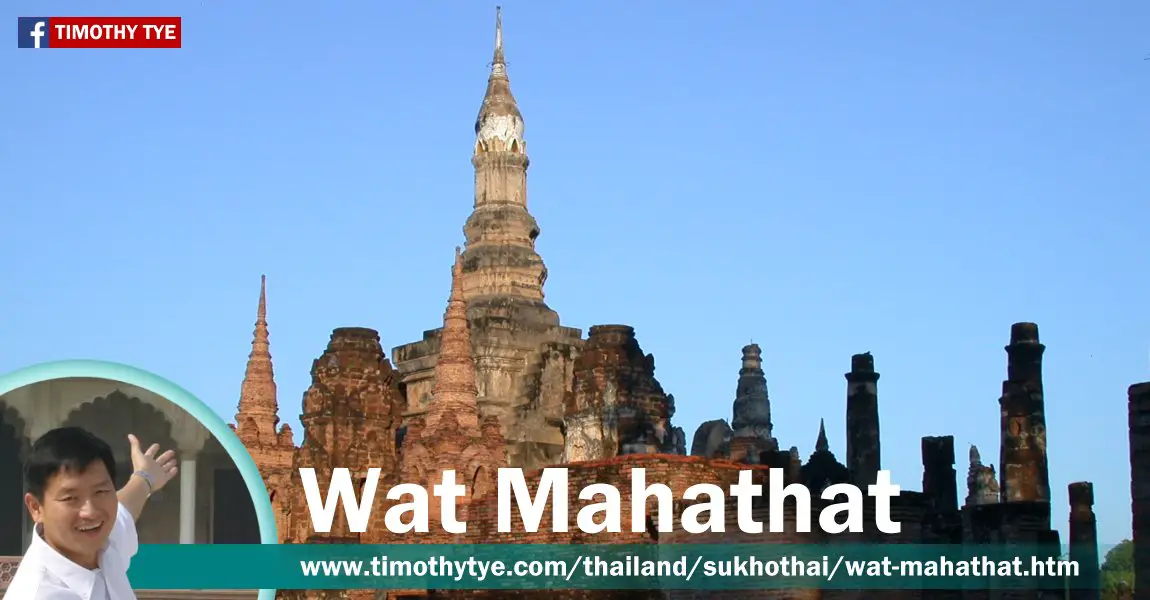 Wat Mahathat, Sukhothai (23 December, 2003)
Wat Mahathat, Sukhothai (23 December, 2003)
[an error occurred while processing this directive] Wat Mahathat (GPS: 17.01687, 99.70369; Thai: วัดมหาธาตุ
 ) is the largest and most prominent cluster of temple ruins within the Sukhothai Historical Park in Sukhothai, Thailand. It is here that you will find some of the most beautiful representations of Theravada Buddhist art, a result of the merging of Thai and non-Thai Buddhist influences. The temple is sites at the heart of the rectangular area of Old Sukhothai, which is now preserved as the historical park. In its present form, it is a huge cluster of ruins, with foundation stones, roofless pillars, Buddha images, pavilions and stupas.
) is the largest and most prominent cluster of temple ruins within the Sukhothai Historical Park in Sukhothai, Thailand. It is here that you will find some of the most beautiful representations of Theravada Buddhist art, a result of the merging of Thai and non-Thai Buddhist influences. The temple is sites at the heart of the rectangular area of Old Sukhothai, which is now preserved as the historical park. In its present form, it is a huge cluster of ruins, with foundation stones, roofless pillars, Buddha images, pavilions and stupas.The name Wat Mahathat means Temple of the Great Relic. It is also known as Wat Yai, meaning The Big Temple. This mammoth temple, when it was a functional one long ago, sits in its own rectangular compound, in which were five ponds, ten viharn (assembly halls), an ubosot (ordination hall), at least one mondop and two hundred chedi (stupas).
It is not known when exactly was Wat Mahathat completed and consecrated. However, the central stupa is believed to have been built after 1292. That's because it wasn't mentioned in Sukhothai Inscription Number One. On the other hand, it would have been built when Sukhothai Inscription Number Two was done around 1346/7, as the inscription did mention that part of Wat Mahathat. Inscription Number Two was authored by Si Satha, and the author may be the one who gave this temple the name we know today, in reference to Buddha's relics (the hair and neck bone) which were brought over from Sri Lanka and installed here during his time, that is, around the 1340s.
Scholars of ancient Buddhist history have suggested that Wat Mahathat may have been built in accordance to the mandala, a representation of the cosmos with the temple's main stupa representing Mount Meru, which is the celestrial abode of the god Indra.
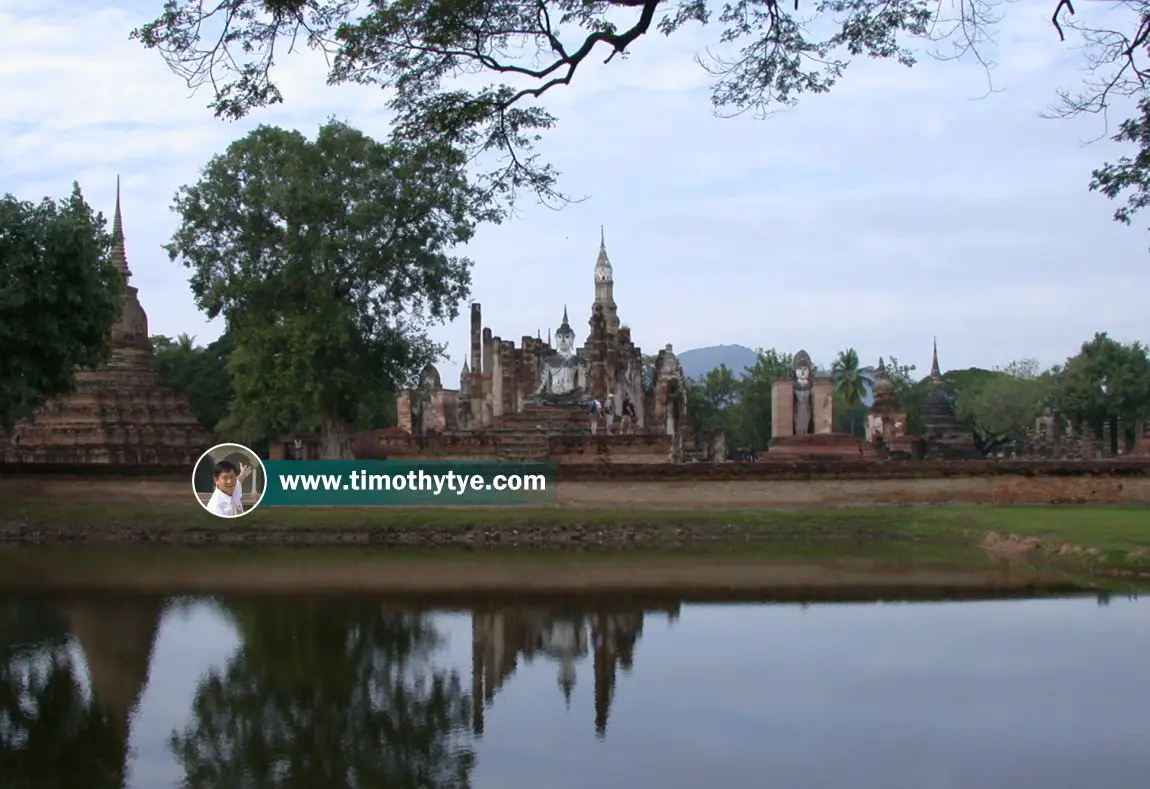 The ruins of Wat Mahathat, in the calmness of the morning. (23 December, 2003)
The ruins of Wat Mahathat, in the calmness of the morning. (23 December, 2003) [an error occurred while processing this directive]
[an error occurred while processing this directive]
Exploring Wat Mahathat
Considering the layout of the Sukhothai Historical Park, most visitors approach Wat Mahathat from the east, and that's my own recommendation to you as well.Start here (GPS: 17.017066, 99.704533
 ) to enter the ruins of Wat Mahathat. (Dec 2014)
) to enter the ruins of Wat Mahathat. (Dec 2014)Go up the steps to the brick base of what was a raised viharn. In front of you is a white stucco seated Buddha statue (GPS: 17.01697, 99.70434
 ), which is in the gesture of subduing Mara. Right behind it is the main stupa of the temple, in its distinctive lotus-bud shape. Even today, the Buddha has become a shrine and is continuously being venerated by locals. Be respectful and no not climb onto the raised platform where the Buddha is located.
), which is in the gesture of subduing Mara. Right behind it is the main stupa of the temple, in its distinctive lotus-bud shape. Even today, the Buddha has become a shrine and is continuously being venerated by locals. Be respectful and no not climb onto the raised platform where the Buddha is located.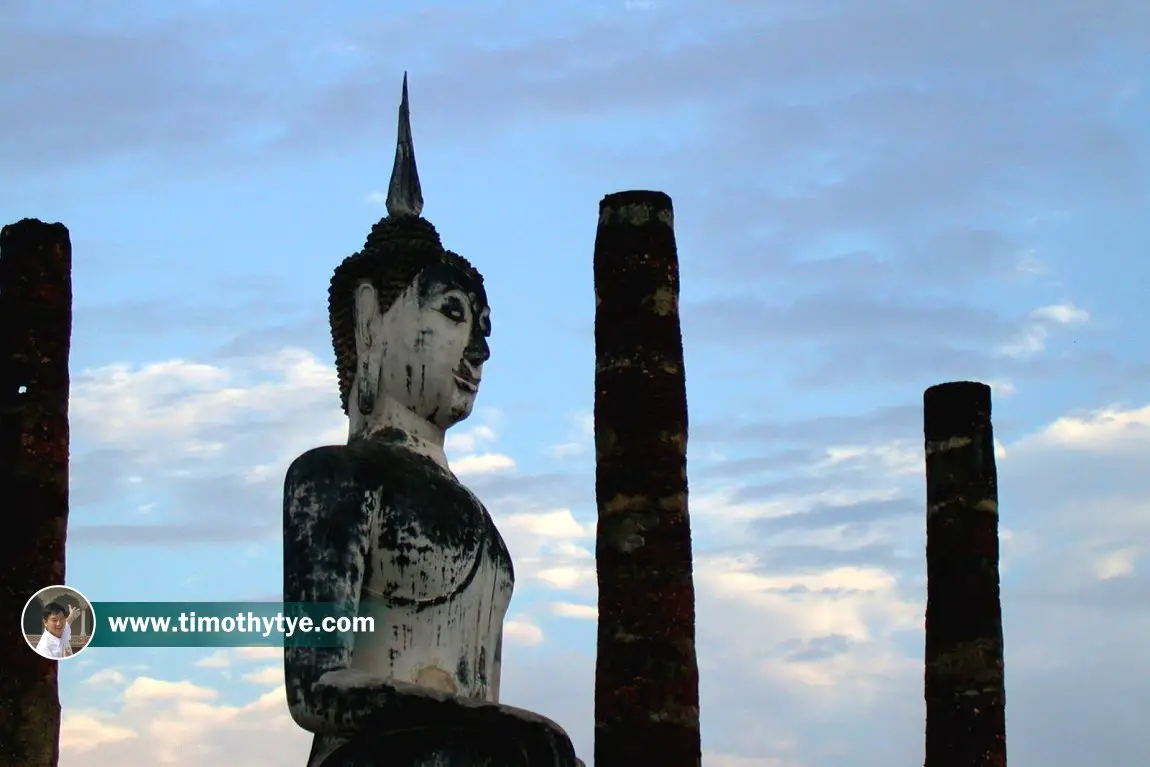 The stucco Buddha of Wat Mahathat, Sukhothai (23 December, 2003)
The stucco Buddha of Wat Mahathat, Sukhothai (23 December, 2003)
Climb down from the raised viharn at the rear of the stucco Buddha. The next building, also the ruins of another viharn (GPS: 17.01695, 99.70409
 ) has a tiled floor with rounded columns. This viharn reflects the late 14th-century Ayutthaya style, rather than the Sukhothai style, so it may have been a later addition to the temple complex.
) has a tiled floor with rounded columns. This viharn reflects the late 14th-century Ayutthaya style, rather than the Sukhothai style, so it may have been a later addition to the temple complex.Ruins of viharn with tiled floor and rounded columns. (Dec 2014)
You will notice raised pedestals this are now empty. One of these pedestals was once occupied by the biggest cast bronze Buddha in the whole of Thailand. The Buddha even has a name, Phra Sri Sakaya Muni. During the reign of King Rama I (1782-1809), that colossal statue was moved from Sukhothai to Bangkok. Today it is housed at Wat Suthat Thepwararam.
[an error occurred while processing this directive] View of empty pedestals at the second viharn. (Dec 2014)
Crossing this second viharn takes you to the core of Wat Mahathat, where you find the lotus-bud stupa (GPS: 17.01687, 99.70369
 ) surrounded by eight other structures, all sharing a common base.
) surrounded by eight other structures, all sharing a common base.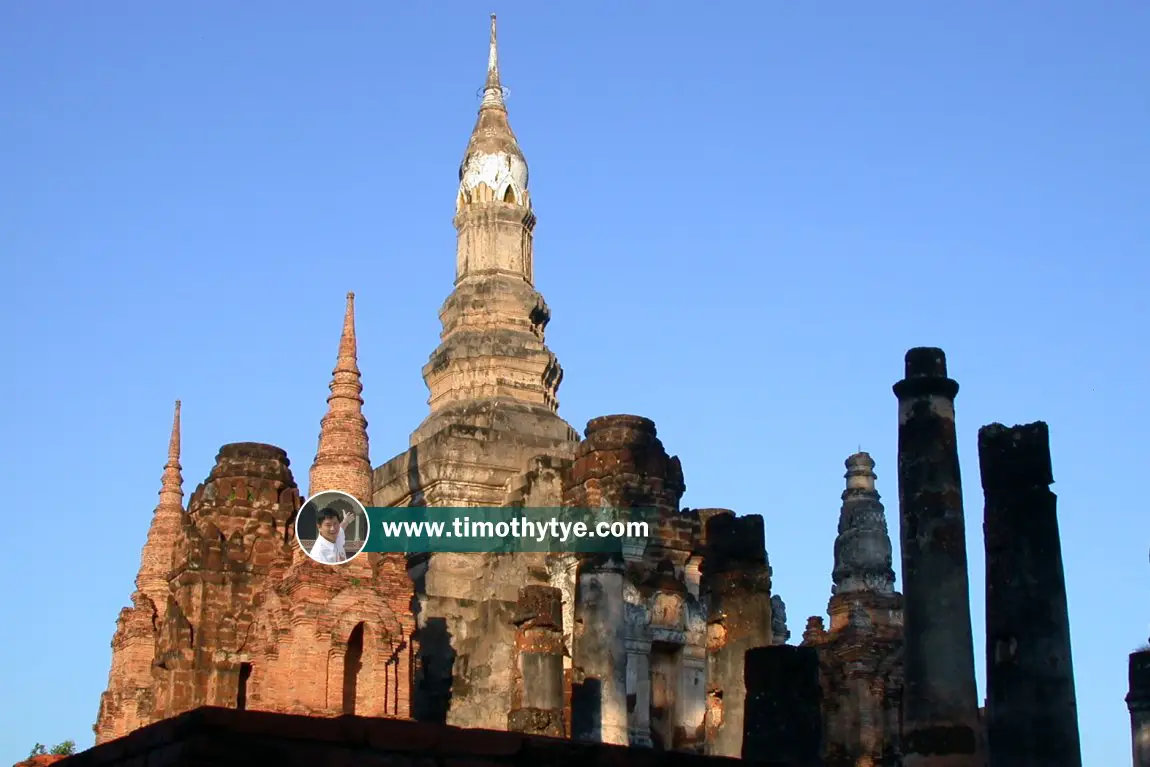 The lotus-bud stupa of Wat Mahathat, Sukhothai, surrounded by other shorter structures. (23 December, 2003)
The lotus-bud stupa of Wat Mahathat, Sukhothai, surrounded by other shorter structures. (23 December, 2003)
View of Wat Mahathat towards its lotus-bud chedi (Dec 2014)
The base of the lotus-bud stupa has moldings that feature stucco reliefs of possibly Buddhist devotees walking around the base of the stupas. At each corner of the base is a pointed stupa
 which is slightly shorter than the central lotus-bud stupa. In between the corner stupas are Khmer-style prangs with rounded tops
which is slightly shorter than the central lotus-bud stupa. In between the corner stupas are Khmer-style prangs with rounded tops  . All these are tightly clustered in the middle of the base.
. All these are tightly clustered in the middle of the base.From this angle, we can see the base with walking devotees supporting the central stupa, four corner stupas and the rounded-top prangs in between them. (Dec 2014)
Flanking the central base, one on the north
 and another on the south side (GPS: 17.01667, 99.70361)
and another on the south side (GPS: 17.01667, 99.70361)  , are two box-like brick structures called mandapa. Housed within each of these is a standing Buddha statue. These standing Buddha statues have names: Phra Attarot, meaning the Eigthteen Buddha, eighteen here referring to its height, which is 18 cubits or roughly 9 meters.
, are two box-like brick structures called mandapa. Housed within each of these is a standing Buddha statue. These standing Buddha statues have names: Phra Attarot, meaning the Eigthteen Buddha, eighteen here referring to its height, which is 18 cubits or roughly 9 meters.There is a legend attached to the south mandapa that there was once a rock standing in front of it. According to the legend, that rock was a Khmer whom Phra Ruang (the kings of Sukhothai is called Phra Ruang) had magically transformed. Alas, the rock has since disappeared.
[an error occurred while processing this directive] Phra Attarot, the standing Buddha at the south mandapa. (Oct 2016)
After the central base, the second largest structure at Wat Mahathat is the Five-Spired Stupa (GPS: 17.01628, 99.70377
 ), which alas, no longer lives up to its name. That's because the first spires have long been gone. What's left is a five-tier base, like five boxes of diminishing sizes, stacked on over the other, with an empty tabletop where the five spires used to be.
), which alas, no longer lives up to its name. That's because the first spires have long been gone. What's left is a five-tier base, like five boxes of diminishing sizes, stacked on over the other, with an empty tabletop where the five spires used to be.The Five-Spired Stupa. (Dec 2014)
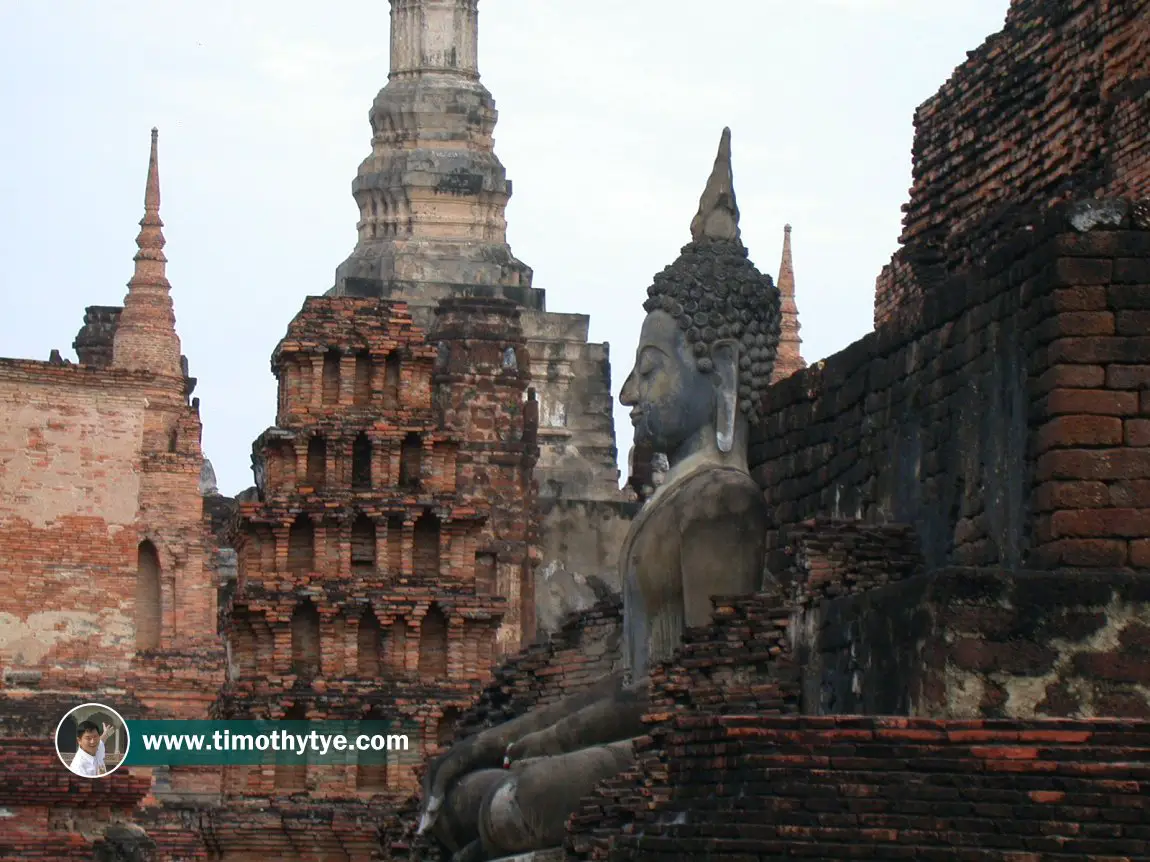 Seated Buddha at the base of the Five-Spired Stupa, with one of the Mon-style stupas, now with empty niches, in the background. (23 December, 2003)
Seated Buddha at the base of the Five-Spired Stupa, with one of the Mon-style stupas, now with empty niches, in the background. (23 December, 2003)
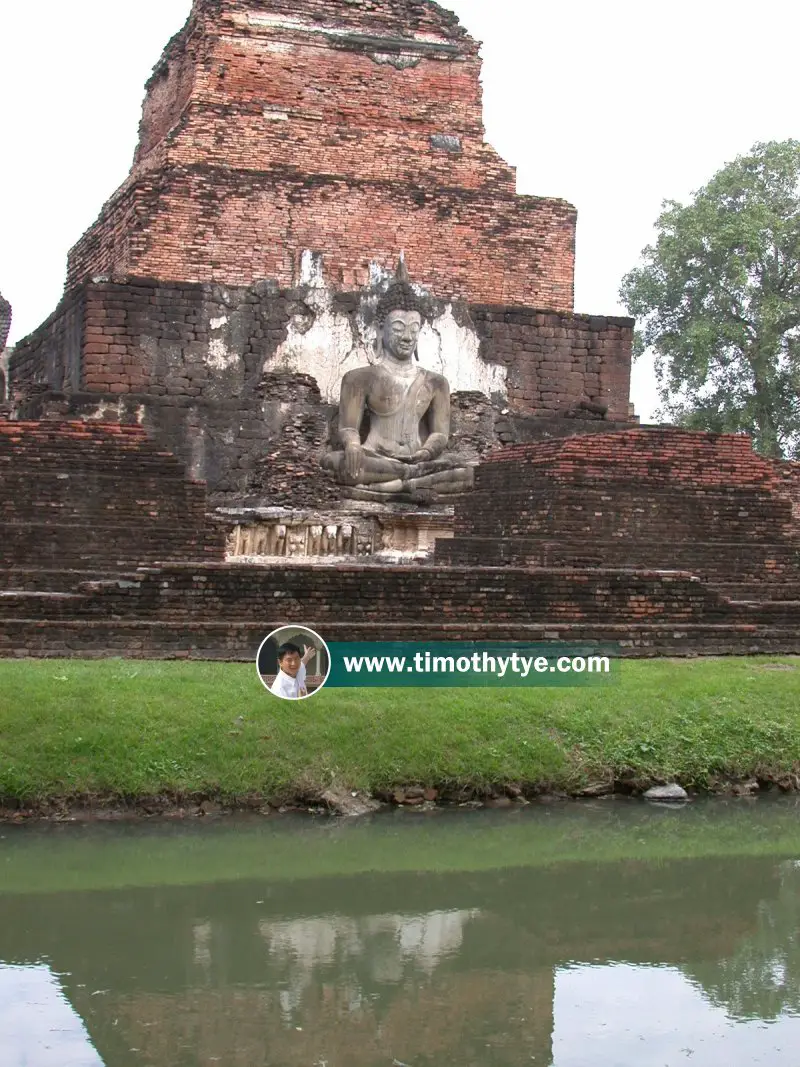 Another seated Buddha at the base of the Five-Spired Stupa. There are brick structures in the foreground, possibly remains of chedis, and in the encircling wall of Wat Mahathat. (23 December, 2003)
Another seated Buddha at the base of the Five-Spired Stupa. There are brick structures in the foreground, possibly remains of chedis, and in the encircling wall of Wat Mahathat. (23 December, 2003)
Going further west, you will see one of the two Mon-style stupas. Built of bricks, these stupas rise from a square base. There are five tiers of diminishing sizes. At each tier are three niches in which there should once be Buddha statues installed in them. This type of stupa design is based on the Mahapol Chedi, which you can see at Wat Chamathewi in Lamphun.
Now leaving the south side of Wat Mahathat, we follow the brick pathway north to view the ubosot or ordination hall (GPS: 17.01729, 99.70343
 ). (Though there is no rigid rule to this, the ordination halls of Thai wats are often placed to the north of the main assembly hall.) As with the various assembly halls at Wat Mahathat, the walls and ceiling of the ubosot has long gone. What we see is a raised brick terrace with protruding rounded columns. At the western end is a large stucco seated Buddha statue in the gesture of subduing Mara.
). (Though there is no rigid rule to this, the ordination halls of Thai wats are often placed to the north of the main assembly hall.) As with the various assembly halls at Wat Mahathat, the walls and ceiling of the ubosot has long gone. What we see is a raised brick terrace with protruding rounded columns. At the western end is a large stucco seated Buddha statue in the gesture of subduing Mara.[an error occurred while processing this directive]
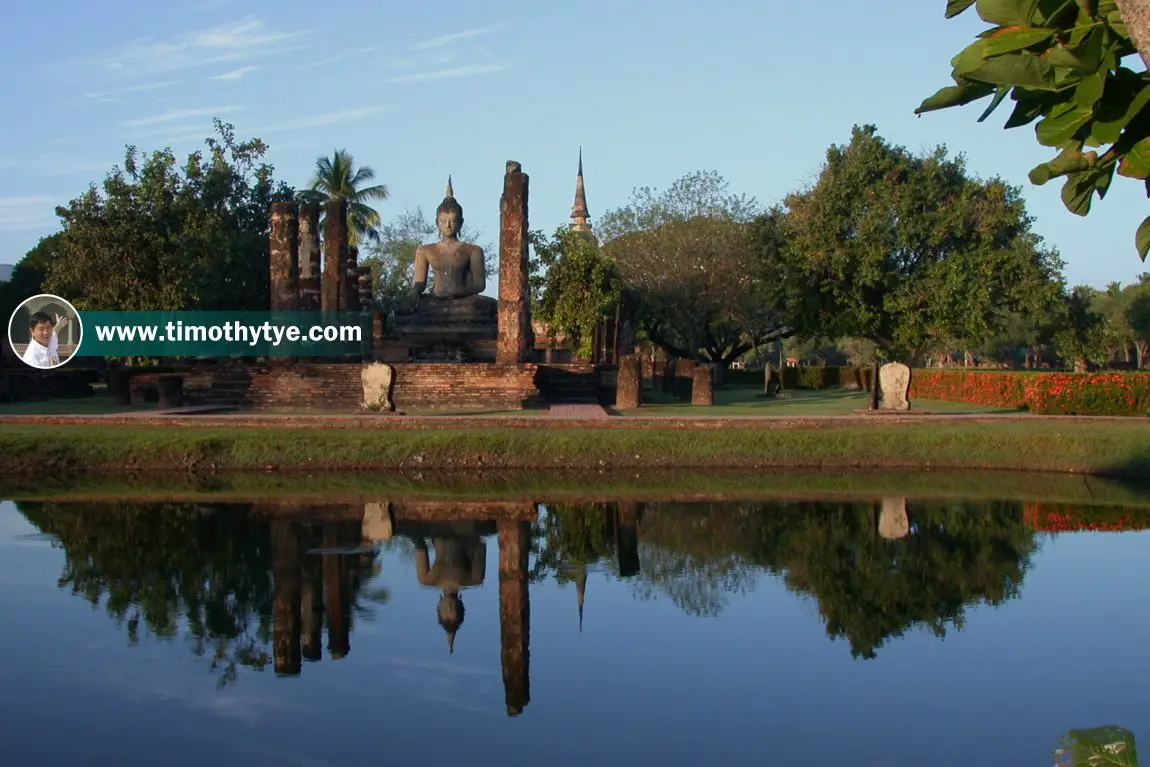 The ruins of the ordination hall of Wat Mahathat. (23 December, 2003)
The ruins of the ordination hall of Wat Mahathat. (23 December, 2003)
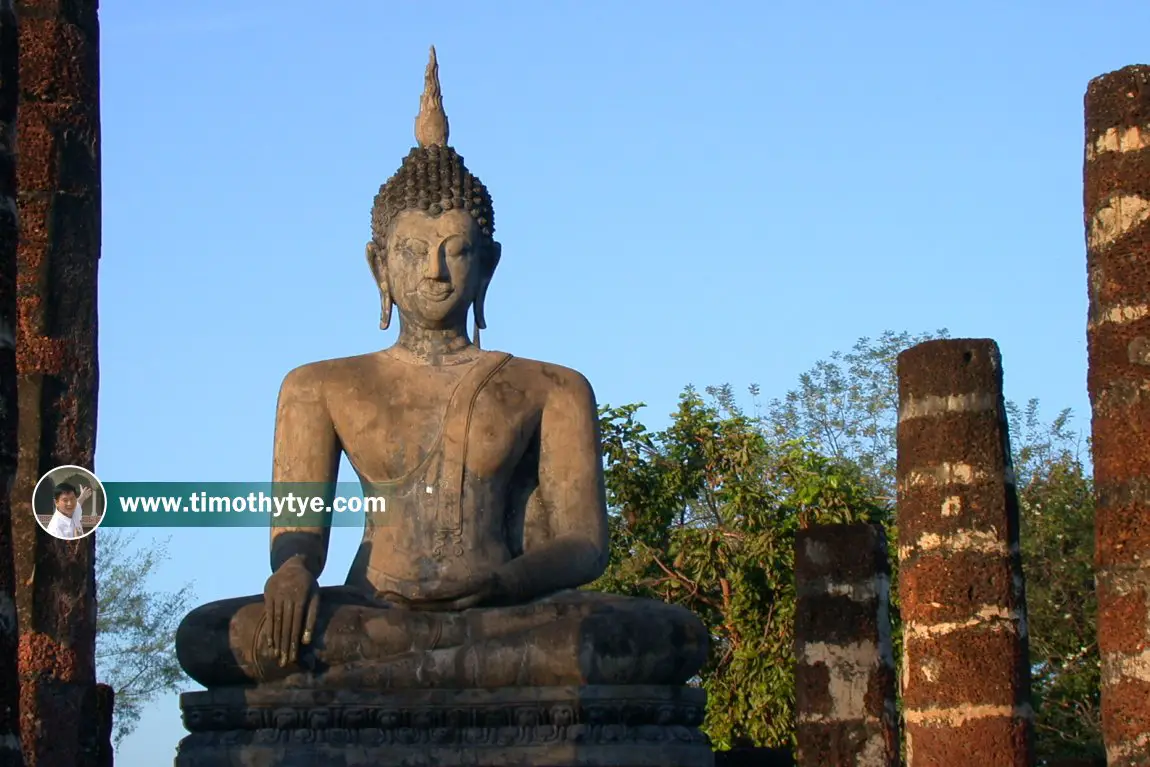 The seated Buddha statue in the ordination hall, in the gesture of subduing Mara. (23 December, 2003)
The seated Buddha statue in the ordination hall, in the gesture of subduing Mara. (23 December, 2003)
Ordination Hall with seated Buddha statue. (Dec 2014)
Wat Mahathat is  on the map of Sukhothai
on the map of Sukhothai
Reference
Ancient Sukhothai - Thailand's Cultural Heritage by Dawn F. Rooney.List of Wats in Sukhothai and Wats in Thailand
 Latest updates on Penang Travel Tips
Latest updates on Penang Travel Tips
 Map of Roads in Penang
Map of Roads in Penang
Looking for information on Penang? Use this Map of Roads in Penang to zoom in on information about Penang, brought to you road by road.
Copyright © 2003-2025 Timothy Tye. All Rights Reserved.

 Go Back
Go Back